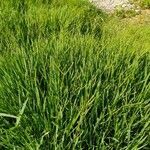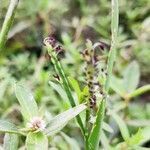Perennial, 100-300 mm high; hydro-to hygrophyte; mat-forming as rhizomatous or stoloniferous and rooting at nodes; culm nodes pubescent. Leaf blade 20-220 x 3-8 mm; ligule an unfringed membrane. Inflorescence digitate to subdigitate, usually 2, secund racemes; rachis dorsally flat, with a raised midrib on front, bearing single spikelets alternately on either side of midrib in 2 or 4 rows; lower glume abaxial, upper lemma facing rachis. Spikelets 2.5-3.5 x 1.3-1.5 mm, lanceolate, dorsiventrally compressed, apex acute, glabrous, awnless, green; glumes unequal; lower glume usually a small triangular scale, or up to 2/3 as long as spikelet to absent (all 3 states can occur on same inflorescence); upper glume minutely hairy especially towards apex, 3-nerved. Florets 2; lower floret sterile, lemma equal, similar to upper glume but flat on back, a prominent median nerve present; upper floret bisexual, lemma hard, obtuse, entire, median nerve present, glabrous, smooth, pallid at maturity, margins narrow and inrolled, clasping only edges of palea; anther 1.0-1.6 mm long. Flowering time Nov.-May.
Stoloniferous; culms 2–5 dm, ascending from a creeping base with conspicuous sheaths; lf-blades relatively short, 2–8 cm × 2–5 mm, ciliate at base; racemes 2, one sessile, the other short-stalked, ascending and often incurved, 2–5 cm, the rachis 1–1.5 mm wide; spikelets solitary, 2.6–3 mm, half as wide, plump, planoconvex, ovate; first glume often developed, triangular, to 1 mm; second glume 5-veined, minutely pubescent, this and the sterile lemma somewhat leathery; 2n=40, 48, 60. Swamps, wet ground, and waste places, often in coastal salt-marshes; mainly in subtropical and warm-temperate regions throughout the world, n. in our range to Ky. and se. Va., and adventive to N.Y. There is some controversy as to whether the name P. distichum should apply to our sp. or to the closely related, more tropical plant usually called P. vaginatum Sw.; in the latter case, our plants take the name P. paspalodes (Michx.) Scribn.
Perennial with rhizomes and stolons. Culms 20–50 cm tall, nodes usually pubescent. Leaf sheaths keeled, glabrous, margins ciliate; leaf blades linear, 5–10 × 0.3–0.7 cm, glabrous, apex acute; ligule 2–3 mm. Inflorescence of 2(–3) racemes arising together or separated by a short axis; racemes 3–7 cm; spikelets single, in 2 rows; rachis straplike, 1.5–2 mm wide. Spikelets pallid, obovate-oblong, plano-convex, 3–3.5 mm, acute; lower glume vestigial or a narrow triangular scale up to 1/2 spikelet length or more; upper glume papery, 3–5-veined with distinct middle vein, loosely appressed pubescent; lower lemma 3–5-veined, usually glabrous; upper lemma pale green, almost equal to spikelet, cartilaginous, apex apiculate and minutely pubescent. Fl. and fr. May–Sep. 2n = 40, 48, 60.
Perennial 100-300 mm high, hydrophyte; mat-forming as rhizomatous or stoloniferous and rooting at nodes; culm nodes pubescent. Leaf blade 20-220 x 3-8 mm; ligule 1.5-3.5 mm long, conspicuous. Inflorescence usually of two racemes; spikelets arranged in two rows, secund. Spikelet 2.5-3.5 x 1.3-1.5 mm, lanceolate, green, apex acute; lower glume usually a small triangular scale up to 2/3 as long as spikelet to absent (all 3 states can occur on the same inflorescence); upper glume 3-nerved, minutely hairy especially towards apex; lower lemma with a prominent midrib; upper lemma smooth, pallid at maturity; anther 1.0-1.6 mm long.
Perennial; up to 0.3 m high; hydrophyte; rooting at nodes; rhizomatous or stoloniferous (matforming). Leaf blades 20-220 x 3-8 mm. Flowers: inflorescence digitate; racemes 2; spikelets 2.5-3.5 x 1.3-1.5 mm; arranged in 2 rows; glabrous; narrowly obovate; apices acute; lower glume usually developed into a small triangular scale or sometimes absent; upper glume minutely hairy.
Creeping, hydrophytic perennial, up to 300 mm tall. Leaves linear; ligule an unfringed membrane. Inflorescence digitate with 2 or 3, 1-sided racemes. Spikelets in 2 rows, 2.5-3.5 mm long, green, ovate, minutely hairy all over, hairs short, awnless; 2-flowered; upper glume as long as to longer than and covering spikelet; lower floret sterile, soft; upper lemma hard, pallid.
Perennial, hydrophyte (rooting at nodes), or rhizomatous or stoloniferous (mat-forming), up to 300 mm tall. Leaf blades 20-220 mm long, 3-8 mm wide. Spikelets 2.5-3.5 mm long, 1.3-1.5 mm wide. Racemes usually 2; spikelets arranged in 2 rows, glabrous, lanceolate, tips acute; lower glume usually developed into a small triangular scale or sometimes absent.
Perennial hydrophyte to 30 cm. Leaves linear. Spikelets in 2 or 3, digitate, spike-like branches, secund in 2 rows, 2.5-3.5 mm long, upper glume minutely hairy.
Inferior glume present on at least some spikelets as a tiny scale. Superior glume somewhat coriaceous, nearly always obscurely pubescent.
Racemes paired (rarely 3), each 2–8 cm. long, the spikelets borne singly in 2 rows on a rhachis 1–2 mm. wide.
A grass. It keeps growing from year to year. It has underground stems or rhizomes and also runners.
Inferior lemma somewhat coriaceous. Superior lemma pallid at maturity.
Spikelets 3–4 mm. long, ovate, plump, green.
Creeping stoloniferous perennial.
Culms 8–60 cm. high.










